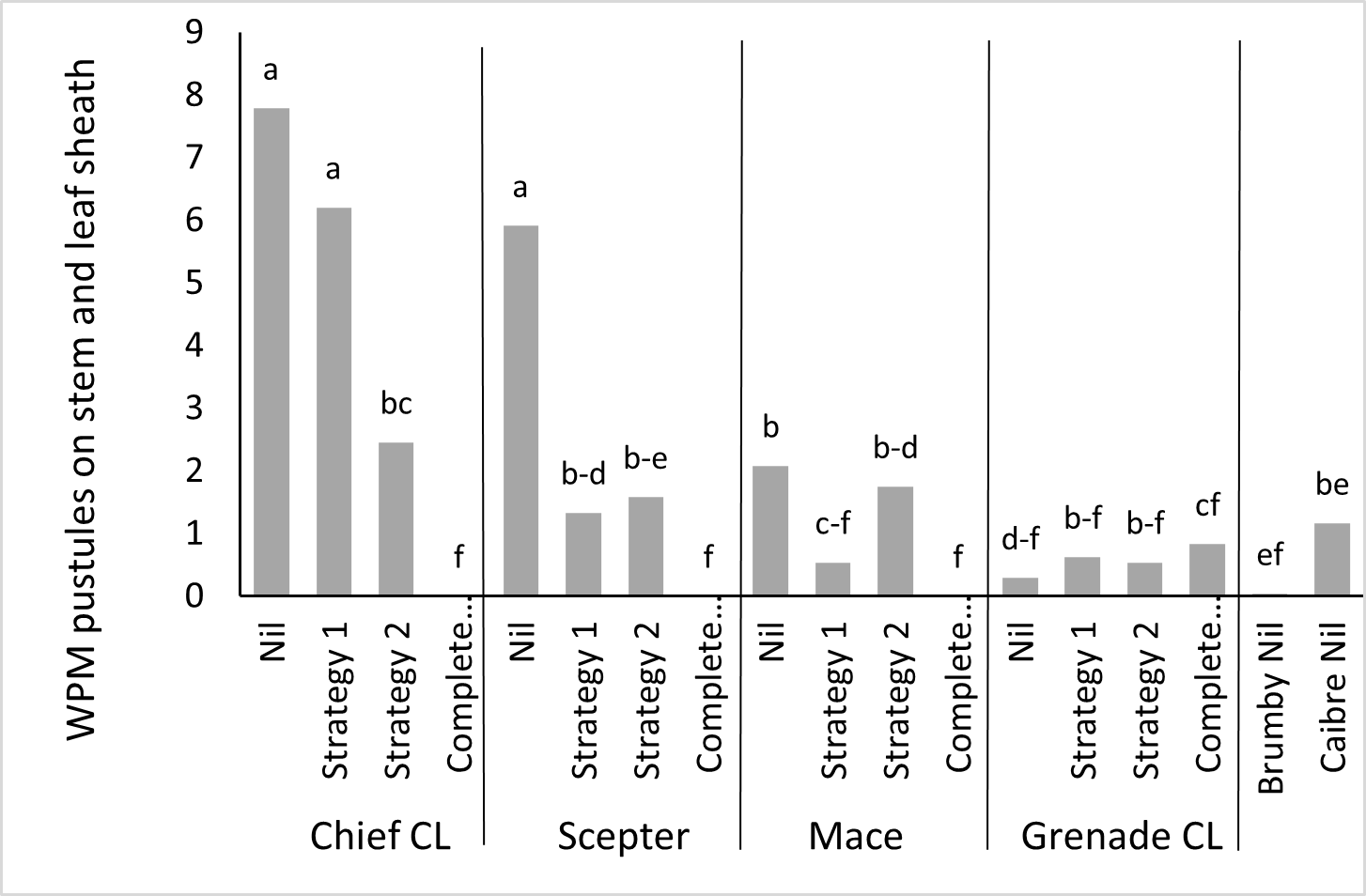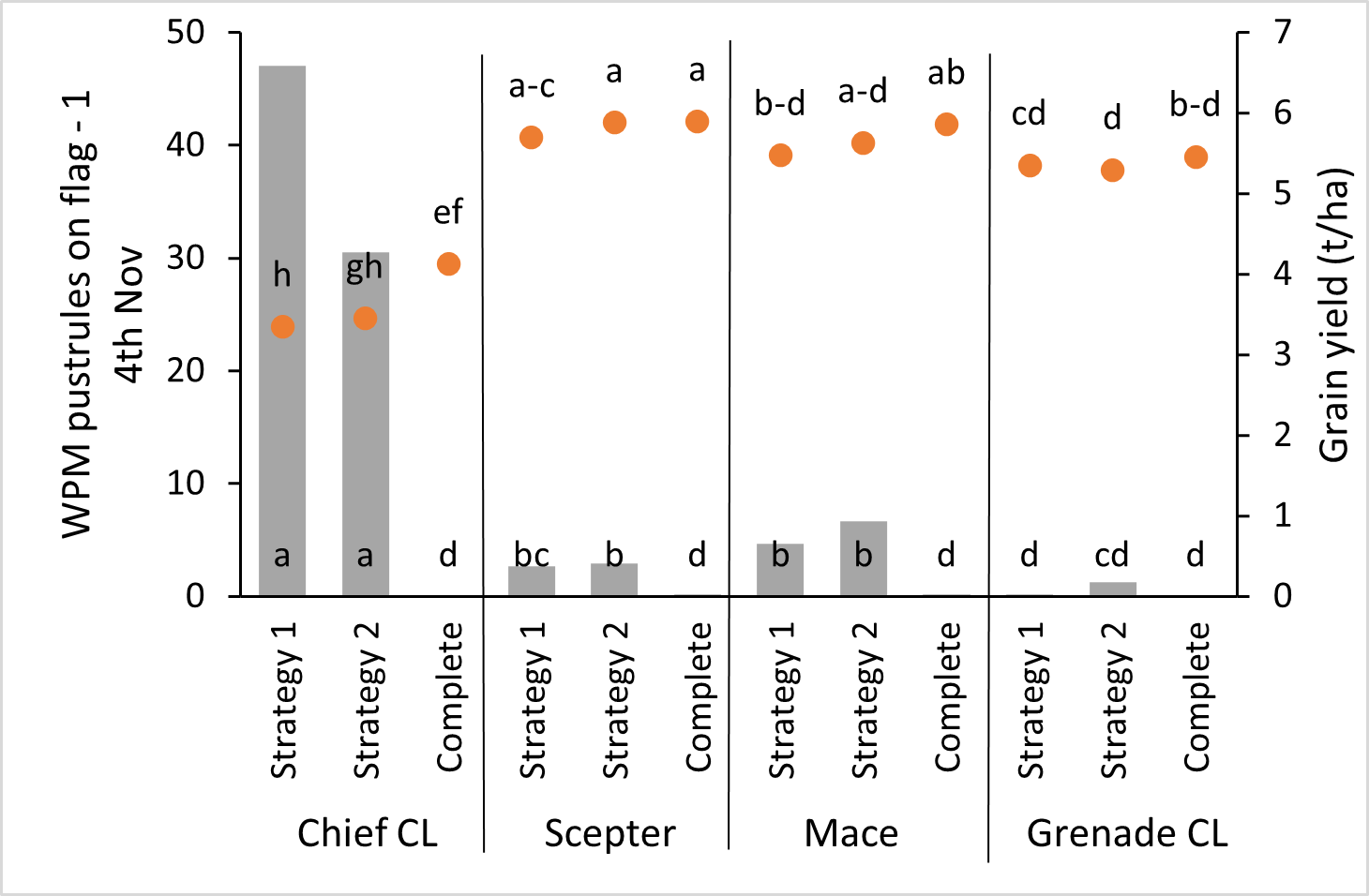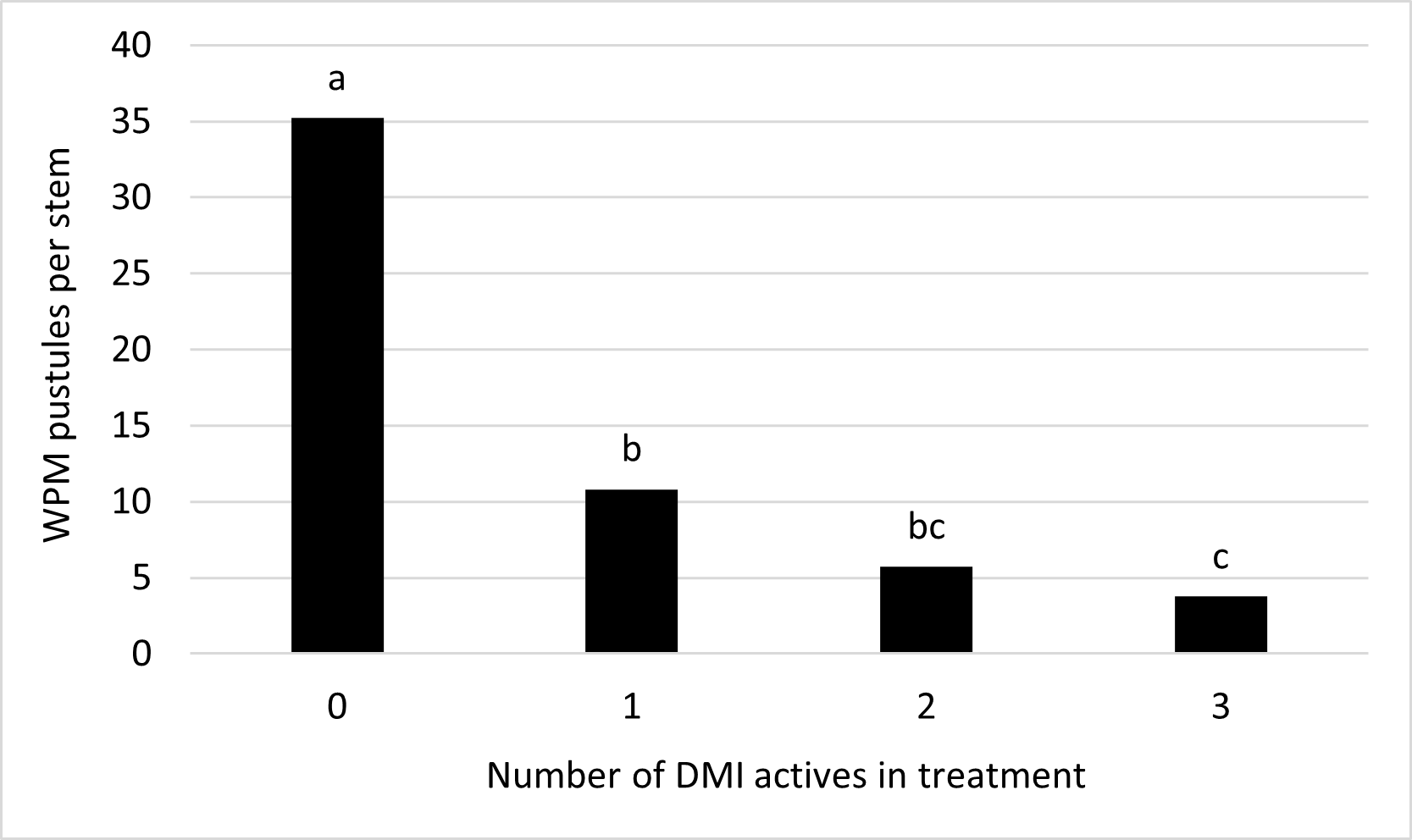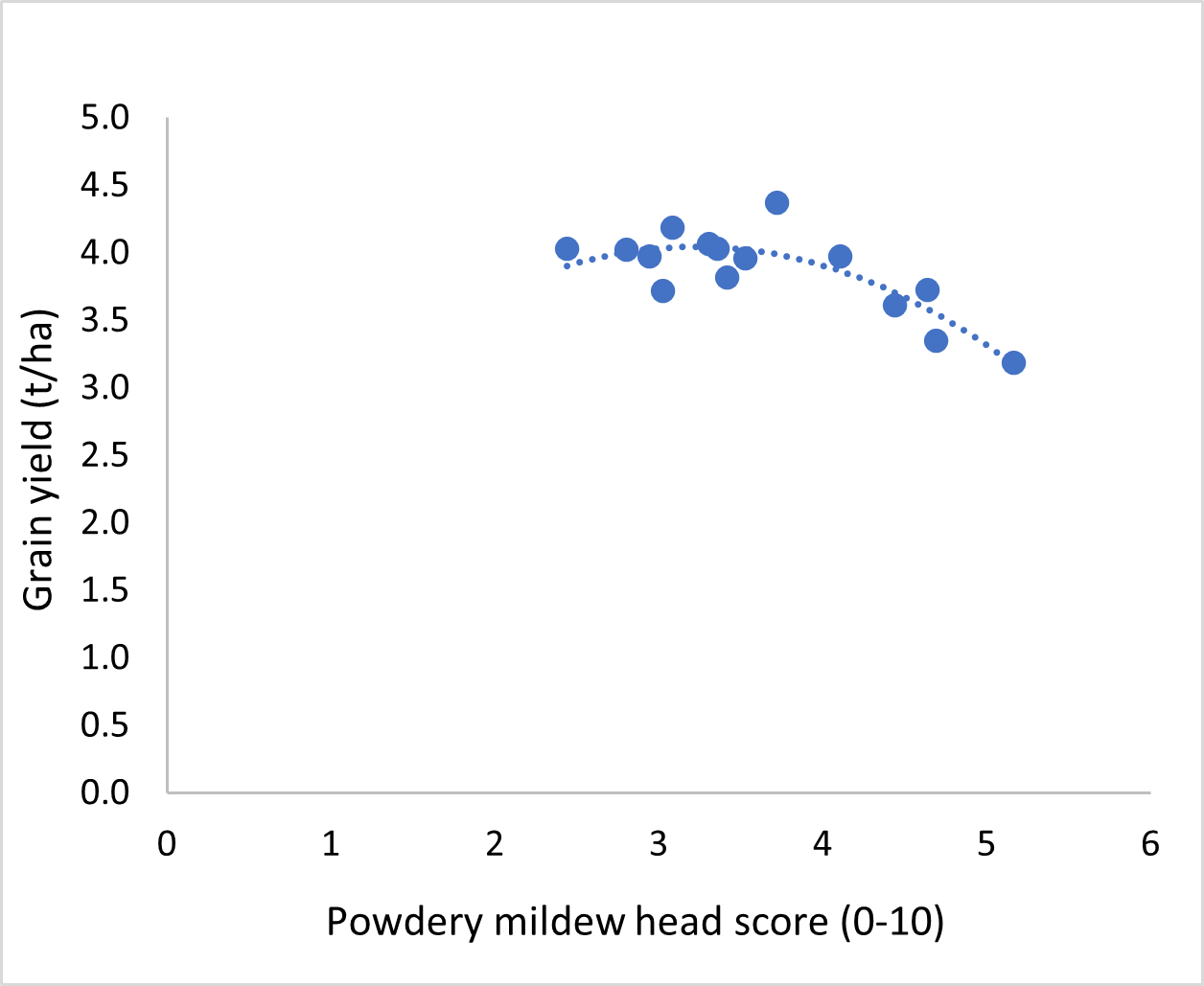Fungicide resistant wheat powdery mildew – update on management and resistance testing
Author: Sam Trengove, Stuart Sherriff, Jordan Bruce, Fran Lopez Ruiz, Kejal Dodhia, Nick Poole and Ben Morris | Date: 27 Feb 2023
Key messages
- Varietal resistance can play an important role in managing wheat powdery mildew. The variety Grenade CL PlusA (MS) had less powdery mildew infection in the untreated than Chief CL PlusA and ScepterA (SVS) treated with a two-spray fungicide strategy. However, Scepter was the highest yielding variety regardless.
- Applying group 11 QoI fungicides increased the frequency of resistance mutation G143A at the QoI target at three trial sites where resistance was present at low levels initially.
- Multiple diseases were present at trial sites this season. Fungicides providing broad-spectrum disease control, particularly for stripe rust, were the highest yielding treatments.
- A permit has been issued for the use of Legend® and other registered quinoxyfen (250g/L) products for control of powdery mildew in wheat. Legend provided good control of WPM at Bute in 2022.
- WPM head infection reduced yield at Port Neill when severity exceeded 40% head infection.
Introduction
Wheat powdery mildew (WPM) was widespread across south-eastern Australia in the 2022 season, occurring in most wheat growing regions, expanding its area of incidence compared with historical occurrence. There are a range of interacting factors that have caused this, including the predominance of SVS varieties grown in most regions over a long period of time, early crop establishment in many regions in 2022, conducive environmental conditions for developing large crop canopies and for disease development and inoculum source carrying over from previous seasons. Difficulty achieving high levels of disease control with what were considered robust and well-timed fungicides were reported in many regions. Increasing prevalence of resistance and reduced sensitivity to group 11 QoI and group 3 DMI fungicides has been implicated in these control failures. Following recent SAGIT project (TC120) findings, investment by GRDC (TRE2204-001RTX) is seeking to quantify the extent of resistance development across the regions and identify management strategies for WPM given resistance development.
Method
Small plot trials were established at four locations in 2022, at Port Neill, Bute and Malinong, SA and Katamatite, Vic. In a range of WPM resistance populations, these trials investigated, post emergent fungicide efficacy, pre-emergent fungicide efficacy, fungicide timing and varietal resistance interactions. Season 2022 was conducive for development of a range of diseases, including Septoria, stripe rust and leaf rust. Three of the four locations were impacted by moderate to high levels of stripe rust, assessments endeavoured to account for these and quantify their impacts in addition to WPM. Assessments included disease incidence and severity, grain yield and grain quality. WPM samples were collected in a Nucleic Acid Preservation (NAP) buffer solution to assess change in resistance frequencies of mutations G143A at CytB, that indicate resistance to QoI, and Y136F at Cyp51 that is associated to other mutations conferring reduced sensitivity to DMI fungicides.
Variety trial: located at Bute, SA. Six varieties including Chief CL (SVS), Scepter (SVS), Mace (MSS), Grenade CL Plus (MS), Calibre (S) and Brumby (R).
Four fungicide strategies were applied to Chief CL, Scepter, Mace and Grenade CL Plus:
- Nil = no fungicide applied
- Strategy 1 = Amistar Xtra @ 400mL GS39
- Strategy 2 = Epoxiconazole125 @ 500mL/ha GS31 fb Amistar Xtra @ 400mL/ha GS39
- Complete = complete control of powdery mildew
Fungicide efficacy trials: four product trials were implemented as small plot randomised complete block designs with 3 or 4 replicates. Trials were located at Bute, Port Neill, Malinong and Katamatite. Bute and Port Neill trials will be discussed in this paper, Bute treatments are shown in Table 3. Product rates at Bute were the high label rate, unless specified otherwise in Table 3. The Port Neill trial was assessing fungicide performance at head emergence timing. The trial site was located within a farmer sown crop that was boom sprayed with Prothio T 420 fungicide at 300ml/ha on 16 August when the crop was at GS33-39.
Table 1. site details for fungicide efficacy trials at Bute and Port Neill
Site | Variety | Date of trial treatments | Growth stage | Number of Treatments | Replicates |
Bute | Chief CL Plus | 16/08/22 | GS31 | 21 | 4 |
Port Neill | Vixen | 5/09/2022 | GS55 | 18 | 3 |
A field survey was conducted with triplicate samples of WPM collected in NAP buffer solution from 145 commercial paddocks in late September and early October for assessing the resistance frequency status of mutations G143A at CytB and Y136F at Cyp51 in regions across SA and Vic, including the Eyre Peninsula, SA Mallee and Upper SE of SA. These add to the database of 51 paddocks sampled from the Yorke Peninsula and Mid North SA in 2021 and 22 paddocks sampled from NE Vic and southern NSW in 2020. The results are not available at the time of writing the paper but will be presented at the updates.
Results and discussion
Varietal resistance to wheat powdery mildew
The benefit of varietal resistance in limiting WPM build up is clear in untreated plots, where WPM pustule number typically follow the variety resistance rating (Figure 1). This is consistent with findings in both 2020 and 2021 (Trengove et al 2021, Trengove et al 2022). In the Bute region, Calibre has performed better than its S rating in both 2022 and 2021 (Trengove at al 2022), being more closely aligned with Mace (MSS) and Grenade CL Plus (MS) in those seasons, respectively. WPM is a highly variable pathogen, and this deviation from expected performance based on resistance rating may reflect the local pathotype that is present. Brumby all but eliminated WPM development, highlighting its R status. Brumby’s high level of resistance is derived from a major gene and supported by alternate minor genes that confer a lower level of resistance. Due to the high genetic variability in WPM, pathotypes may already exist that can overcome this major gene resistance and have virulence on this variety, where virulence will then depend on the performance of the minor genes. This was observed in a small isolated hot spot in Brumby in 2021 in a WPM variety trial at Bute, SA (Trengove et al 2022). Therefore, Brumby is expected to provide excellent resistance when first grown in a region. However, there is a risk it will be overcome by more virulent pathotypes if they are selected across a wide area on a repeated basis. The timeframe over which this may occur will depend on the frequency and regional extent of virulent pathotypes in the WPM population, and the area of varietal selection. This makes rotating varieties an important strategy in managing WPM.
In a SVS variety like Chief CL a robust fungicide program like strategy 2 was required to reduce WPM levels significantly, but still had more WPM than Grenade CL (MS) with no fungicide treatment. Untreated plots were severely affected by stripe rust and leaf rust late in the season, being the main influence on yield in those plots (data not shown). With the nil plots excluded due to stripe rust, within variety, there was no grain yield difference between fungicide programs, except for the variety Chief CL (Figure 2). WPM continued to develop late in the season in Chief CL resulting in a 0.67t/ha difference between Strategy 2 and complete WPM control. Responses of similar magnitude were recorded in SVS varieties in 2020 and 2021 to WPM control (Trengove et al 2021, Trengove et al 2022).

Figure 1. Variety by fungicide trial at Bute 2022 Note: WPM pustules on the stem and leaf sheath assessed 27/9/2022 (Pr(>F) = <0.001)

Figure 2. Variety by fungicide trial at Bute 2022 Note: WPM pustules on the Flag minus 1, assessed 4/11/2022 (Pr(>F) = <0.001) and final grain yield (Pr(>F) = <0.001).
Wheat powdery mildew fungicide resistance and post-emergent fungicide performance
Mutation frequency for Y136F at Cyp51 was high at all trial sites averaging over 99%, regardless of treatment. This indicates that the gateway mutation associated with reduced sensitivity to group 3 fungicides is saturated at all trial site locations likely due to the strong selection pressure that wheat powdery mildew populations are under because of the reliance on DMI fungicides. Trial sites at Bute in 2020 and 2021 had 70% and 87% frequency of Y136F mutation and is consistent with survey data indicating this reached saturation in a relatively short time period.
Mutation frequency for G143A at CytB that confers resistance to group 11 QoI fungicides ranged from 1.2–24% across sites in the untreated control (Table 2). There is a trend for treatments containing the group 11 fungicide azoxystrobin to increase this frequency across the sites. This is expected, where the continual use of group 11 QoI fungicides maintains selection pressure on the population. This is consistent with 2021 results from Bute where treatments including azoxystrobin increased mutation frequency from 19 to 48.5% (Trengove et al 2022).
Table 2. Fungicide treatment effect in four product efficacy trials on frequency of G143A mutation at CytB, conferring resistance to group 11 QoI fungicides
Treatment | Bute | Katamatite | Malinong | Port Neill | |||
Nil | 1.2 | c* | 24 | c | 4.2 | 2.0 | b |
Epoxiconazole (3) | 4.9 | b | 38 | bc | 6.8 | 2.2 | b |
Azoxystrobin (11) | 9.2 | a | 45 | bc | 10.6 | 4.1 | a |
Tazer Xpert (3 + 11) | 5.8 | ab | 70 | ab | 12.3 | 1.6 | b |
Tebuconazole (3) | 53 | ab | |||||
Veritas (3 + 11) | 79 | a | |||||
Prothioconazole (3) | 2.4 | bc | |||||
Maxentis (3 + 11) | 5.3 | b | |||||
Aviator Xpro (3 + 7) | 3.1 | bc | |||||
Pr (>F) | 0.002 | 0.022 | 0.107 | 0.011 | |||
*Letters denote treatments that are significantly different.
WPM control at Bute was poor with single active DMI products being no better than the untreated (Table 3). Dual active DMI Prosaro® provided some control. Azoxystrobin reduced WPM infection, both standalone and in the dual active group 3 and 11 mixtures. Given low levels of QoI resistance at the site this is not unexpected, however is not likely to be a long-term solution given ongoing selection for resistant individuals (Table 2). Aviator Xpro® is a DMI plus SDHI mix but is no better than the standalone prothioconazole DMI component (Proviso® 250EC), which is consistent with previous results. Telbek® Adavelt® is a new group 21 fungicide and provided useful WPM control at this site.
Legend® fungicide and other registered products with quinoxyfen (250g/L) have been issued Permit 93197 for use in wheat for the control of powdery mildew at use rates of 200-300mL/ha. The permit is in place for 18 months. Critical use comments from the label include:
- Apply at the first signs of infection as a protectant treatment only.
- Monitor crops regularly from early tillering and apply at or before GS31.
- Monitor if conditions favour disease development and reapply from 21 to 28 days after the first application and no later than GS39.
- Apply foliar application by ground boom.
- Use higher rates where conditions favour disease development.
- Use a spray volume of 50-100 L/ha.
- DO NOT apply more than 2 applications per crop.
- DO NOT apply less than 21 days after the initial treatment.
- DO NOT apply after the growth stage GS39.
- Apply quinoxyfen in accordance with the current CropLife Fungicide Resistance Management Strategy.
These comments will need to be factored in when planning to use Legend for WPM control.
Legend® provided high levels of WPM control at Bute in 2022 (Table 3), and this result is consistent with trial results in 2020 and 2021. Several experimental products tested also provided high levels of control. It is important to note that diseases do not occur in isolation though, and broad-spectrum fungicides were required to control all diseases present at the site including stripe rust, Septoria tritici, Wirrega blotch and WPM. Stripe rust infection and its control was the biggest determinant of grain yield and products that controlled stripe rust were the highest yielding, where the untreated control yielded 20% of the best treatments. Legend® and the experimental products provided no stripe rust control and were only marginally better than untreated control for grain yield. Mildew specific fungicides such as Legend® will need to be applied with an appropriate mix partner to provide broad spectrum disease control.
Table 3. Fungicide effect on wheat powdery mildew, Wirrega blotch & Septoria tritici, stripe rust and grain yield in Chief CL wheat at Bute, SA, 2022
Product | WPM canopy score 28th Sept | a WPM pustules/stem 28th Sept | b Blotch Score 28th Sept | Rust canopy score 16th Oct | Rust canopy score 4th Nov | Grain yield (t/ha) | ||||||
Nil | 3.0 | a | 1.0 | a | 37 | bc | 9.3 | a | 9.9 | a | 0.66 | j |
Tebuconazole430 | 2.8 | a | 0.8 | a-d | 18 | f-h | 1.5 | h | 4.1 | h | 2.69 | d-f |
Opus® 250mL/ha (GS39 only) | 2.6 | ab | 0.9 | ab | 33 | b-e | 1.5 | h | 4.0 | hi | 2.53 | d-g |
Opus® 500mL/ha | 2.6 | ab | 0.9 | a-c | 16 | gh | 0.5 | i | 2.6 | jk | 2.85 | b-d |
Propiconazole | 2.4 | a-c | 0.8 | a-c | 20 | d-h | 3.0 | fg | 6.9 | f | 2.53 | d-g |
Proviso® 250EC | 2.3 | a-d | 0.8 | 3 | 18 | e-h | 5.5 | c | 8.4 | cd | 2.36 | fg |
Prosaro® | 2.1 | a-d | 0.6 | c-f | 21 | d-h | 1.0 | hi | 3.3 | i-k | 3.07 | a-c |
c Mirador® 625 (azoxystrobin) | 2.3 | a-d | 0.6 | c-f | 12 | h | 2.8 | g | 5.4 | g | 2.57 | d-g |
Veritas Opti® | 1.8 | b-e | 0.5 | d-g | 24 | c-h | 1.0 | hi | 3.4 | h-j | 2.67 | d-g |
Amistar Xtra® | 1.5 | c-e | 0.5 | d-g | 20 | d-h | 1.5 | h | 3.9 | hi | 3.23 | a |
Tazer Xpert® | 1.4 | d-f | 0.4 | f-h | 12 | h | 1.3 | hi | 2.6 | k | 3.19 | ab |
Maxentis® | 1.6 | c-e | 0.4 | f-i | 31 | b-g | 4.0 | de | 6.9 | f | 2.74 | c-e |
Aviator Xpro® | 1.8 | b-e | 0.7 | b-e | 10 | h | 4.8 | cd | 7.1 | ef | 2.41 | e-g |
Telbek® Adavelt® | 1.1 | ef | 0.4 | f-h | 20 | d-h | 6.5 | b | 8.9 | bc | 1.65 | h |
dLegend® | 0.5 | fg | 0.0 | j | 34 | b-d | 9.0 | a | 9.9 | a | 1.04 | i |
Telbek® Adavelt® + TC EXP 01 | 0.1 | g | 0.1 | hij | 32 | b-f | 6.8 | b | 9.2 | a-c | 1.54 | h |
Telbek® Adavelt® + TC EXP 01 + Proviso® 250EC | 0.0 | g | 0.1 | ij | 29 | b-g | 4.8 | cd | 7.7 | de | 2.31 | g |
TC EXP 01 | 0.0 | g | 0.5 | efg | 32 | b-f | 9.0 | a | 9.9 | a | 0.98 | ij |
TC EXP 02 | 0.5 | fg | 0.3 | f-i | 40 | ab | 6.8 | b | 9.1 | bc | 1.57 | h |
TC EXP 04 | 0.0 | g | 0.2 | g-j | 54 | a | 9.0 | a | 9.6 | ab | 1.06 | i |
Pr (>F) | <0.001 | <0.001 | <0.001 | <0.001 | <0.001 | <0.001 | ||||||
LSD (0.05) | 0.875 | 0.3 | 15 | 0.9 | 0.8 | 0.36 | ||||||
adata has been transformed to log10(1 + pustule count)
bblotch score is the leaf area percent of the flag minus 1, 2 and 3 affected by necrosis caused by Wirrega blotch and Septoria tritici combined.
cMirador® 625 is registered in wheat only when mixed with a DMI mix partner. It has been applied standalone in this trial for research and demonstration purposes.
dLegend is available for use under PER93917.
When QoI group 11 fungicides are rendered ineffective due to resistance, and control from SDHI group 7 fungicides is typically low, the DMI group 3 fungicides have been the remaining fungicidal control option, albeit at reduced levels due to reduced sensitivity. A trial at Bute investigated the effect of applying DMI actives at full label rates, standalone or in two-way and three-way mixes, to try and optimise control. Active ingredients included tebuconazole, epoxiconazole and prothioconazole. Results indicate that increasing the load of DMI by applying active ingredients in combination provided better control than applying the actives as standalone treatments (Figure 3).

Figure 3. Total WPM pustule number assessed on the Flag minus 1, 2 and 3 and the lower stem on 29/9/2022 for Chief CL treated with group 3 DMI fungicide combinations
Fungicide applied at head emergence at Port Neill resulted in different levels of WPM head infection, with treatment scores ranging from 2.4 to 5.2 in the untreated (Figure 4). The relationship between WPM head infection and grain yield indicates when the head score was less than 4 there was little difference in grain yield but declined when the head score exceeded 4, where the untreated control yielded 3.2t/ha. A head score of 4 indicates approx. 40% of the head has mildew growth.

Figure 4. WPM head score in Vixen wheat at Port Neill on 03/11/2022 and grain yield response (Y = -0.232x2 + 1.494x +1.637, R2 = 0.689).
References
Trengove, S., Sherriff, S., Bruce, J. Lopez Ruiz, F. (2021). Management of powdery mildew on fungicide resistant wheat, 2021 GRDC Adelaide Grains Research Update.
Trengove, S., Sherriff, S., Bruce, J., Lopez Ruiz, F and Dodhia, K. (2022). Fungicide resistant wheat powdery mildew – management and resistance testing, 2022 GRDC Online Grains Research Update
Acknowledgements
The research undertaken as part of this project is made possible by the significant contributions of growers through both trial cooperation and the support of the GRDC, the author would like to thank them for their continued support. PER93917 is a result of SAGIT and GRDC investments, field studies and regulatory, and the support of Grain Producers Australia (GPA) as the permit holder. The input during this project from Tara Garrard is gratefully acknowledged.
Contact details
Sam Trengove
Trengove Consulting, Bute SA
Phone 0428262057
Email samtrenny34@hotmail.com
@TrengoveSam
AVarieties displaying this symbol beside them are protected under the Plant Breeders Rights Act 1994
GRDC Project Code: TRE2204-001RTX,
Was this page helpful?
YOUR FEEDBACK
